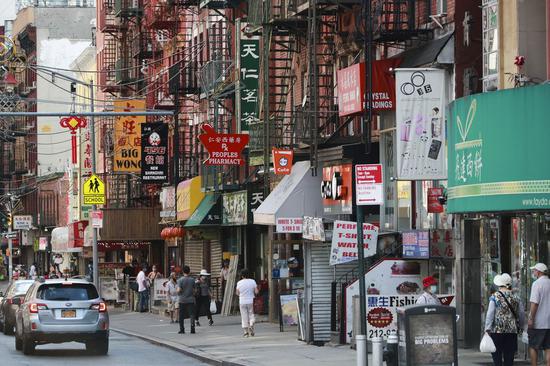
People walk in a street in Chinatown in Manhattan of New York, the United States, June 24, 2020. New York City entered phase two of reopening on Monday, marking a major milestone of the city's fight against COVID-19. (Xinhua/Wang Ying)
Special:New York City's restaurant industry has been thrown from its pinnacle in 2019 after a decade of rapid development to the bottom by the ravaging COVID-19 pandemic this year, and is now facing a gloomy future in 2021, according to an official report recently issued by the state government of New York.
UP TO 50 PCT POTENTIAL CLOSURE
Various estimates project that during the next six months to a year, one-third to one-half of the city's restaurants and bars that existed prior to the pandemic may close permanently, according to "The Restaurant Industry in New York City: Tracking the Recovery" issued by Office of the New York State Comptroller and approved by New York State Comptroller Thomas P. DiNapoli and Deputy Comptroller Rahul Jain.
If one-third of them close, the city would lose nearly 8,000 establishments in the industry, and 106,000 jobs. If the closures rose to 50 percent, nearly 12,000 restaurants and bars would shutter and almost 159,000 jobs would be lost, according to the report.
"Since March 2020, the restaurant industry has been hit very hard by the COVID-19 pandemic," said the report, adding that "mandatory closures, stay-at-home and social distancing orders, the onset of a severe economic recession, and travel restrictions have resulted in unprecedented upheaval for the industry."
"As a result, many restaurants and bars have closed or significantly reduced their operations. Since these establishments often operate on tight margins in the best of times, there are growing fears that many will be forced to close permanently if financial support is not forthcoming," it added.
In March 2020, New York City became the epicenter of the pandemic in the nation, causing unprecedented effects, and by April, restaurant employment had dropped to 91,000 jobs as severe restrictions were imposed on business practices. As rules loosened and outdoor dining was permitted, employment rose, reaching 174,000 jobs in August, according to the report.
PAINFUL STRUGGLE
Since the pandemic began, many restaurants have explored new business models in order to generate revenues. Some establishments that had not offered takeout and delivery began those services. Others operated as specialty food markets offering items not available at local stores, said the report.
Still others sold do-it-yourself kits with menu items such as pizza and tacos, or offered gourmet meals requiring minimal preparation. With outside financial support to cover costs, some restaurants became food banks, it added.
"Another strategy involved obtaining permits for safe outside dining," said the report, adding that on June 19, 2020, the city started the Open Streets program, which issued special sidewalk and roadway permits.
At the end of June, the city expanded its Open Streets program, which closed off streets to vehicle traffic, to allow restaurants that participated in the Open Streets program to set up tables in the traffic-free streets. Throughout the summer, new locations and additional hours were added to the Open Streets program.
"While the programs were slated to end in the fall, the Mayor intends to make them year-long and permanent," the report added.
Many restaurants in Chinatown have been shut down while restaurants outside of Chinatown are in a better situation, Winston Wang, who operates a tax service firm in Chinatown in Lower Manhattan, told Xinhua.
Still, many restaurants only manage to continue to operate for the time being thanks to governmental stimulus and delay of rent payment, said Wang, whose clients are mostly restaurant owners.
"If a new round of stimulus package doesn't come out, I don't know how long the restaurants could continue to keep doors open," he added.
HISTORICAL PINNACLE
The restaurant industry in New York City saw its highest number of establishments and jobs in 2019 after a decade of job growth that was more than double the rate for local jobs overall, said the report.
In 2019, the city's restaurant industry reached its historical top, with 23,650 establishments, 317,800 jobs, 10.7 billion U.S. dollars in total wages paid citywide, and nearly 27 billion U.S. dollars made in taxable sales.
"Despite relatively lower average wages, restaurants provide a steady source of jobs for many residents, particularly Hispanic and Asian minority populations and immigrants," it added.
Prior to the COVID-19 pandemic, from 2009 to 2019, jobs in the restaurant industry grew by 61 percent and establishments grew by 44 percent, double the overall rate of growth, said the report.
"More than 60 percent of NYC resident restaurant workers were immigrants in 2018, compared to 45 percent across all occupations; in 16 neighborhoods the share was between 70 percent and 90 percent," it added.
Restaurants lend vitality to each neighborhood and are integral to Manhattan's central business districts and the city's vibrant tourism industry, attracting millions of visitors each year who spend a total of 46 billion U.S. dollars annually, said the report.
"The industry is the second largest component of tourism spending, behind lodging," it added.
Residents and tourists alike are drawn to live in and visit areas with thriving retail corridors anchored by restaurants. The industry contributed about 15 percent of total taxable sales citywide in 2019, according to the report.
"The restaurant industry is essential to New York City's social and economic fabric. From small, family-owned restaurants and food carts to four-star world-famous establishments, the City abounds with restaurants that offer cuisines from every corner of the globe," it added.
POTENTIAL LIFELINE
Descending the pinnacle in 2019 to the bottom in 2020 and even the abyss in 2021, the NYC restaurant industry has been trying to find its lifeline and stay afloat.
"On average, 44 percent of restaurants have used outdoor seating, suggesting reduced operations and closures are significant and may continue if further operational or financial support is not forthcoming," said the report.
The next six months to one year would be the most crucial time for restaurants as the catering sector faces mounting pressures, said Nicky Chang, head of design and strategy with Junzi Kitchen, a fast-casual Chinese restaurant chain.
"It's very important for restaurant operators to seize opportunities to renovate itself amid the stark challenges brought by COVID-19," said Chang, whose restaurant launched a new Chinese takeout brand "Nice Day" which focuses on American Chinese food.
The takeout food under Nice Day has been widely welcomed since its launch and Junzi Kitchen intends to acquire struggling peers and build up a network of takeout business under "Nice Day."
Restaurants are one of the keys that make New York City a world-class metropolis, said the report, adding that "These businesses are a vital element that helps draw concentrations of retail and arts and entertainment to thrive in the City, and imbue neighborhoods with character and individuality."
Recent reopening guidelines for 25 percent of indoor dining capacity provide a step forward in this direction and can and should be enhanced based on feedback from businesses, it said.
"In addition, the availability of loan and grant funds, both directly from the City and through the facilitation of State and federal grants, should support bridging the economic-activity gap faced by establishments, particularly in the City's hardest hit areas," added the report.




